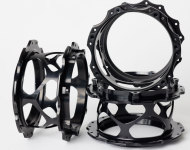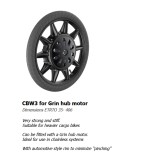Mongo
1 kW
I'm considering converting a mid-drive bike I have to rear hub motor drive, and I can go 135mm O.L.D. bolt/QR or 148mm x 12mm thru-axle. The former would give me more motor vendor options, while the latter path would have to be via Grin. The wheel size would preferably be 650B/27.5", or 26" if necessary, with semi-knobby tires (along the lines of the Schwalbe Marathon MTB in 2.25"). with fenders. And, I want 9-speed cassette capability.
I only have limited hub motor experience, and that's with a RH212.
The intended use for the bike would be on mild incline paved/pea gravel rails to trails, ~50-75 miles per day assisted range, at ~12-15mph (for battery range conservation), but with short distance bursts of ~30mph tops to travel short distances off-trail to B&B/hotel/food locations. Rolling weight would be ~325lbs.
So why consider the Grinmotor? Is the convenience of the thru-axle, torque arm choices, and "all-in-one electronics" worth the rather lofty purchase price? Another negative may be that little/no troubleshooting or repair is possible on the Grin motor without delacing the rim - though maybe this doesn't matter, as I wouldn't be able to get repair parts anyway, away from home and all.
So what's the question? I guess it's, has anyone else considered the Grin hub and been put off by the reparability nuisance? Is there a particularly high failure point? It's also hard to shake the pricepoint - I could have primary and spare motors/wheels in other brands, compared to one Grin motor.
But ... there's something "technically sweet" about the Grin motor, and it might allow me to integrate a Rohloff-inspired torque arm idea I've had (a takeoff of the Rohloff OEM dropout torque containment).
Given the lowish speed, mild terrain, and longish range requirements, which hub motor path would you choose?
I only have limited hub motor experience, and that's with a RH212.
The intended use for the bike would be on mild incline paved/pea gravel rails to trails, ~50-75 miles per day assisted range, at ~12-15mph (for battery range conservation), but with short distance bursts of ~30mph tops to travel short distances off-trail to B&B/hotel/food locations. Rolling weight would be ~325lbs.
So why consider the Grinmotor? Is the convenience of the thru-axle, torque arm choices, and "all-in-one electronics" worth the rather lofty purchase price? Another negative may be that little/no troubleshooting or repair is possible on the Grin motor without delacing the rim - though maybe this doesn't matter, as I wouldn't be able to get repair parts anyway, away from home and all.
So what's the question? I guess it's, has anyone else considered the Grin hub and been put off by the reparability nuisance? Is there a particularly high failure point? It's also hard to shake the pricepoint - I could have primary and spare motors/wheels in other brands, compared to one Grin motor.
But ... there's something "technically sweet" about the Grin motor, and it might allow me to integrate a Rohloff-inspired torque arm idea I've had (a takeoff of the Rohloff OEM dropout torque containment).
Given the lowish speed, mild terrain, and longish range requirements, which hub motor path would you choose?
Last edited:






